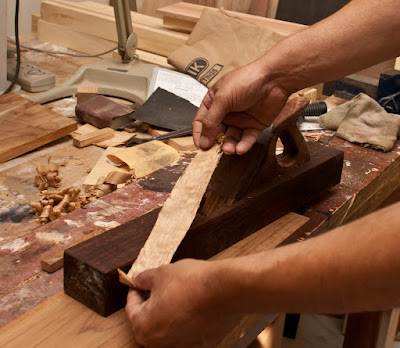 |
| The plane without its blade |
I finally got a chance to try out Mousam Ali's wooden jointer plane this morning. I had been wanting to get my hands on the plane all week but had found no time. I had however managed to give it a rub of Mustard oil as recommended by the toolmaker.
The blade had been sharpened at precisely 25 degrees by the toolmaker without any honing guide on a 320 Carborundum stone and worked well enough but I wanted to see how the plane would perform with a highly sharpened blade.
I honed it to 8000 grit, gave a slight micro bevel and lightly honed its back bevel as well. Once a blade has been given a back bevel, honing it is a must. I generally avoid establishing a back level but in this case had no choice but to polish it as the toolmaker had already given the blade a back bevel.
 |
| Black steel cap iron |
 |
| Cap iron attached with a rusted old bolt and washer |
I noticed that the cap iron, an old piece of black steel, was attached to the blade by a rusted bolt and wide washer. It required a small wrench to tighten. The wooden wedge fitted perfectly in its slot and after a bit of adjustment with a small hammer, the plane was ready to go.
Mousam Ali, the toolmaker, had recommended that I use the plane by holding the tote with three fingers, index finger pointing straight out. My left hand was to rest on the front portion of the plane to keep it down and my fingers away from the front where they could get crushed.
 |
| Recommended stance (the tote is held incorrectly in this photograph) |
This was a fairly comfortable stance and worked well for me. The plane effortlessly took out full length shavings and flattened a board of hard teak in no time.
 |
| A fulllength shaving |
I was also impressed by the lack of fatigue I experienced in using this wooden plane. In comparison, a 22 or 24 inch iron jointer can be quite a drag after a while.
The idea of light wooden planes had always appealed to me and now I know how good they could feel in action.
Yet, this is not a finishing tool in the sense it is principally meant for flattening boards and planing the edges of a board for joining. I could however easily adjust the depth of the cut by administering a light hammer tap on the end of the plane and get pretty fine shavings if needed.
In all this is a beautiful tool which I intend to use as much as possible.
Indranil Banerjie
11 October 2015
Hello, thanks for the useful post. Where can I get a plane like this?
ReplyDeleteThey are available locally throughout the country. You just have to ask around. Try your local carpenter.
Delete